I have written before about how the Late Neolithic sample from Zvejnieki seemed to be an outlier among Corded Ware samples (read also the Admixture analysis section on the IEDDM), due to its position in PCA, even more than its admixture components or statistical comparison might show.
In the recent update to Northern European samples in Mittnik et al. (2018), an evaluation of events similar to the previous preprint (2017) is given:
Computing D-statistics for each individual of the form D(Baltic LN, Yamnaya; X, Mbuti), we find that the two individuals from the early phase of the LN (Plinkaigalis242 and Gyvakarai1, dating to ca. 3200–2600 calBCE) form a clade with Yamnaya (Supplementary Table 7), consistent with the absence of the farmer-associated component in ADMIXTURE (Fig. 2b). Younger individuals share more alleles with Anatolian and European farmers (Supplementary Table 7) as also observed in contemporaneous Central European CWC individuals2.
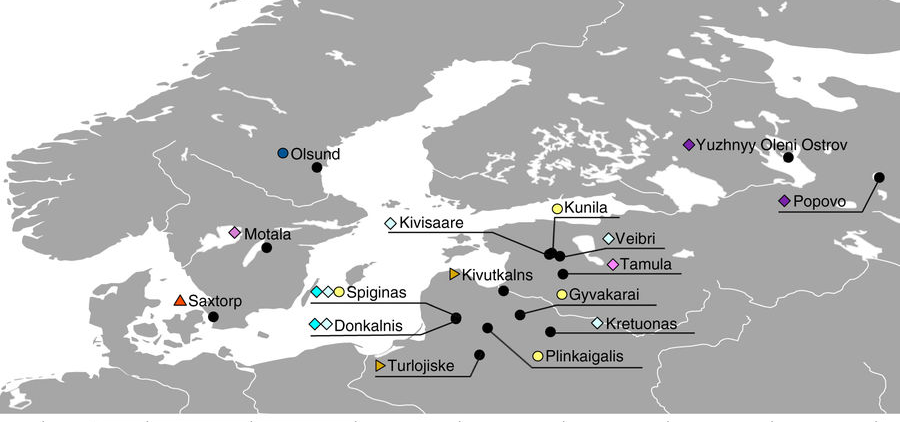
My interpretation of the Zvejnieki sample ca. 2880 BC (and thus also of the only Baltic LN sample forming a close cluster with it) as ‘outlier’ seems thus reinforced as more samples come in. My explanation based on exogamy is one possibility for the region. After all, great mobility and exogamy practices are universally accepted for the Corded Ware territory, and Yamna migrants had settled up along the Prut precisely around this period (ca. 3100-2900 BC), so this kind of relation between Yamna and Baltic samples is to be expected.
NOTE: Information on the Late Neolithic burial of Zvejnieki is scarce, since it is an isolated find in radiocarbon analysis, among Mesolithic burials. You can read more about it from Ilga Zagorska’s studies, such as The use of ochre in Stone Age burials of the East Baltic (2008), The persistent presence of the dead: recent excavations at the hunter-gatherer cemetery at Zvejnieki (Latvia) (Antiquity 2013), or Dietary freshwater reservoir effects and the radiocarbon ages of prehistoric human bones from Zvejnieki, Latvia (J. Archaeol. Sci. 2016).
Samples of Baltic “Late Neolithic / Corded Ware culture”
The only two samples clustering more closely to Yamna cluster also closely to the three previous samples from Khvalynsk in Samara (labelled ‘Steppe Eneolithic’ in the paper), which makes one wonder how strongly connected were cultures from the forest and forest-steppe zones before the expansion of Corded Ware and Yamna settlers.
NOTE: Apart from the scarcity of samples available, which is common in genetic studies, the description of both additional ‘outlier’ samples of the Baltic Late Neolithic – isolated finds based mainly on radiocarbon analysis – leaves a lot to the imagination, because of the lack of cultural context and potential problems with dating methods:
Plinkaigalis 242, >40 year old female (OxA-5936, 4280 ± 75 BP, 3260–2630 calBCE). The burial site is located in the plains of central Lithuania on the eastern bank of the river Šušvė on the outskirts of the Plinkaigalis village, approximately 400 m southeast of an Iron age hill fort and settlement. The burial site was discovered in 1975 when local residents started digging for gravel in the western part of the hill. The same year site was granted a legal protection with archaeological excavations carried out for eight straight years in a row (1977-1984). During the eight years of fieldwork a total of 373 graves (364 inhumation and 9 cremation graves) with all but two of them dating to 3rd to 8th c. AD were uncovered. The two exceptional graves (no. 241, 242) were uncovered in the northern part of the burial site and C14 dated to the Late Neolithic.
Gyvakarai 1, 35-40 year old male (Poz-61584, 4030 ± 30 BP, 2620–2470 calBCE). The burial site is located in the northern part of Lithuania on the steep gravelly bank (elevation up to 79 m a. s. l.) of the rivulet Žvikė, 500 m to the south from where, in the wet grassland valley, it meets the main stem river Pyvesa. The site was discovered in 2000 when local residents started digging for gravel in the central part of the gravelly bank. The same year rescue excavations were conducted in the surrounding area of the highly disturbed grave resulting in discovery of a single grave C14 dated to the Late Neolithic.
EDIT (16 FEB 2018): A commentator noted that Gyvakaray1 was also studied for Yersinia pestis, a disease which appears to have expanded first to the west from the steppe, and then to the east, so it is possible that its position in PCA related to Plinkaigalis242 shows a connection to late Yamna settlers or East Bell Beaker migrants.
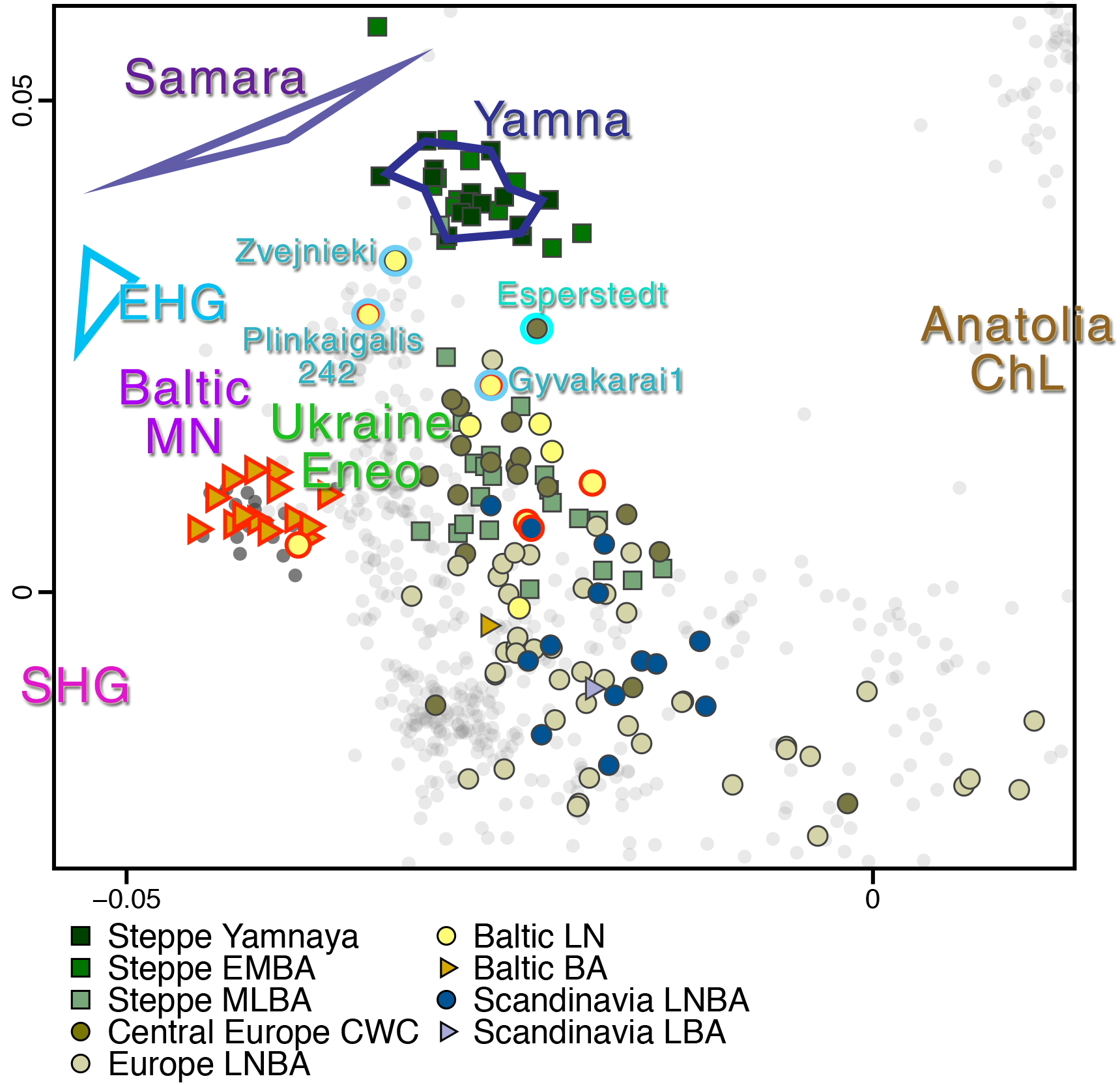
NOTE: I haven’t had the time and patience to work with my virtual computer on the PCA of these new samples – my CPU is reaching everyday its limit and my fans work half the time – , so I don’t know exactly which of them is Plinkaigalis242 and which Gyvakarai1, I just made a wild guess (based on ADMIXTURE) that the earlier Plinkaigalis242 forms a common ‘outlier’ group with Zvejnieki; if they are reversed or otherwise wrong in the image, please correct me. It will be much appreciated.
We can see from the additional samples in Mittnik et al. (2018) that the common cluster formed by most Baltic LN samples in PCA (most of them with clear cultural context among Late Neolithic or Corded Ware material, unlike the two ‘outliers’ and Gyvakarai1) is among Ukraine Eneolithic samples, European Corded Ware samples, and also Mesolithic-Neolithic samples from the Baltic. This is a logical find in light of the mainstream opinion that the expansion of the third horizon of the Corded Ware culture seems to have begun in the Dnieper-Dniester region (a corridor of steppe, steppe-forest, and forest zones) ca. 3300 BC.
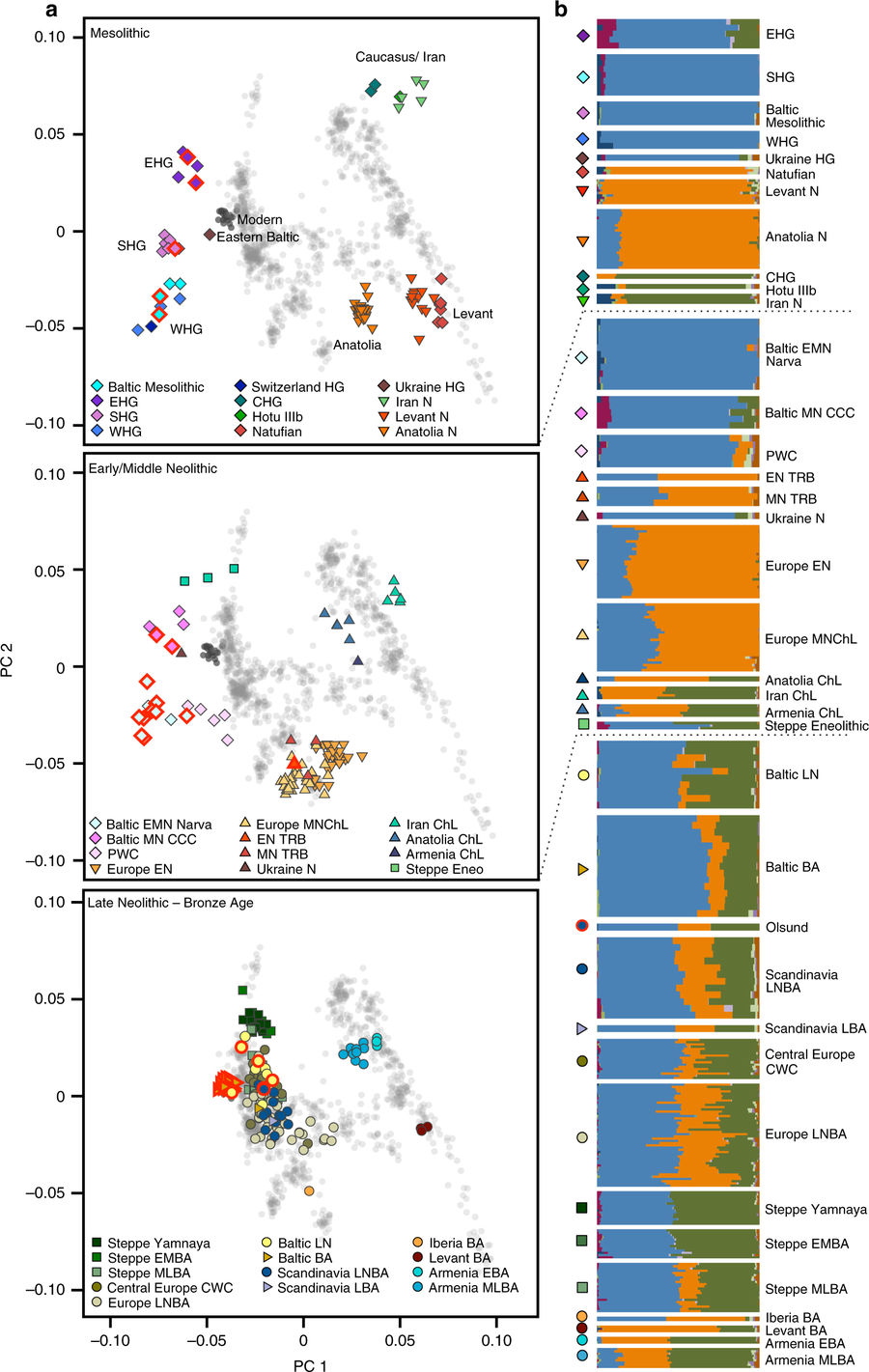
Corded Ware culture origins
If we take the most recent reliable radiocarbon analyses of material culture, and interpretations based on them of Corded Ware as a ‘complex’ similar to Bell Beaker (accepted more and more by disparate academics such as Anthony or Klejn), it seems that the controversial ‘massive’ Corded Ware migration must have begun somehow later than previously thought, which leaves these early Baltic samples still less clearly part of the initial Corded Ware culture, and more as outliers waiting for a more precise cultural context among Late Neolithic changes in the region.
Their situation in PCA among Khvalynsk (Samara), Baltic Mesolithic, East Hunger-Gatherer samples, Yamna and Eneolithic Ukraine leaves us without enough information to understand their actual origin.
EDIT (3 FEB 2018): In the first edition of my IEDDM paper I based the potential expansion of the Corded Ware culture mainly on Piezonka’s detailed analyses of the evolution of Mesolithic and Neolithic cultures in the forest-steppe and Forest Zone, and on later phylogeographic finds, since there were no samples from these regions in this interesting period. I revised it in the second edition to accomodate the model to the Indo-Uralic proto-language supported by the Leiden school, and identified it with a a close Neolithic-Chalcolithic steppe community based on common language guesstimates and – after the latest revision of Mathieson et al. (2017) – on the appearance of steppe admixture in the steppe.
However, if traditional Uralicists are right in supposing a loose Neolithic community in the Forest Zone, and Kristiansen is right in supposing long-lasting contacts in the Dniester-Dnieper region, we might actually be seeing with these ‘outliers’ the first proof that Neolithic samples from the forest-steppe and Forest Zone of the 4th millenium – unrelated to the Corded Ware culture – clustered closely to Khvalynsk, Sredni Stog, or Yamna samples, which is compatible with Piezonka’s accounts of intercultural contacts.
Martin Furholt‘s assessment of the origin of the A-horizon of the Corded Ware culture would put the early dates of Late Neolithic in the Baltic coinciding with or just before the initial expansion of Corded Ware migrants. For example, here are some excerpts (emphasis mine) from Re-evaluating Corded Ware Variability in Late Neolithic Europe (2014), in Proceedings of the Prehistoric Society (you can read it free at Academia.edu):
Radiocarbon analysis
Acceptance of the results of radiometric dating meant that the concept of the so called ‘A-Horizon’ also had to be reformulated. If we are dealing with such a phase at all, it is not a classic typological period that is defined by a uniform material culture inventory, but rather a set of types which show a wide distribution, but which are always integrated into a locally specific and thus regionally variable context.
The situation resembles that of the Bell Beakers, where a few supra-regional types are associated with local forms of ‘Begleitkeramik’ (i.e. pottery that accompanies Bell Beakers: Strahm 1995; Besse 1996).
The distribution data indicate that this set of forms (namely the A-Beaker, ‘A-Amphora’, and A-Battle Axe, as well as Herringbone-decorated Beakers) was to be found over much of Europe around 2700 BC, and that the currency of these forms was not short: they seem to have been used continuously during the Final Neolithic, perhaps even until 2000 BC (Fig. 3; Furholt 2004). Analysis of the radiometric and dendrochronological determinations also indicates that the A-Horizon is not the earliest Corded Ware phase. Instead, it appears to follow an apparent earlier phase in Poland during which Corded Ware pottery was in use from as early as 2900 BC (Furholt 2003; 2008a; Wödarczak 2006; Ullrich 2008).

Corded Ware and Yamna/Bell Beaker
While widening networks and a change in the mechanism of exchange appears to have contributed to the emergence of the Corded Ware archaeological phenomenon, and also the contemporaneous Yamnaya graves (Harrison & Heyd 2007) and the following Bell Beaker and Early Bronze Age phenomena, it remains to be seen exactly what factors contributed to the development of these systems. It may be that there were changes in subsistence practices, perhaps involving a rising importance of animal herding that subsequently required higher mobility (for a discussion see Dörfler & Müller 2008), but considering the obvious diversity in subsistence patterns present in different Corded Ware groups, such an explanation would seem appropriate for the transformation in some regions, but surely not for the eastern hunterfisher-gatherer groups of the Baltic (Bläuer & Kantanen 2013). Also, trade with amber and copper might have played its role, but there are so far no indications for a significant rise in quantity or reach of these two materials in connection with Corded Ware graves or settlements (Furholt 2003, 125–7).
The impacts of animal traction and the wagon are also to be taken into account, as they are present since 3400 BC (Mischka 2011) but does at least not play any visible role in Corded Ware burial rituals, very much in contrast to the previous periods (Johannsen & Laursen 2010). There is no evidence for horse riding, but the domesticated horse seems to be present in central Europe since before 3000 BC (Becker 1999) and have also been found in Corded Ware settlements (Becker 2008), but again the evidence of domesticated horses is much more abundant in the period before 3000 BC.
So, concerning amber and copper exchange, or the impact of the wheel and animal traction, there is the recurrent motive of stronger evidence for the period before 3000 BC than during or in connection to Corded Ware finds after 2700 BC.
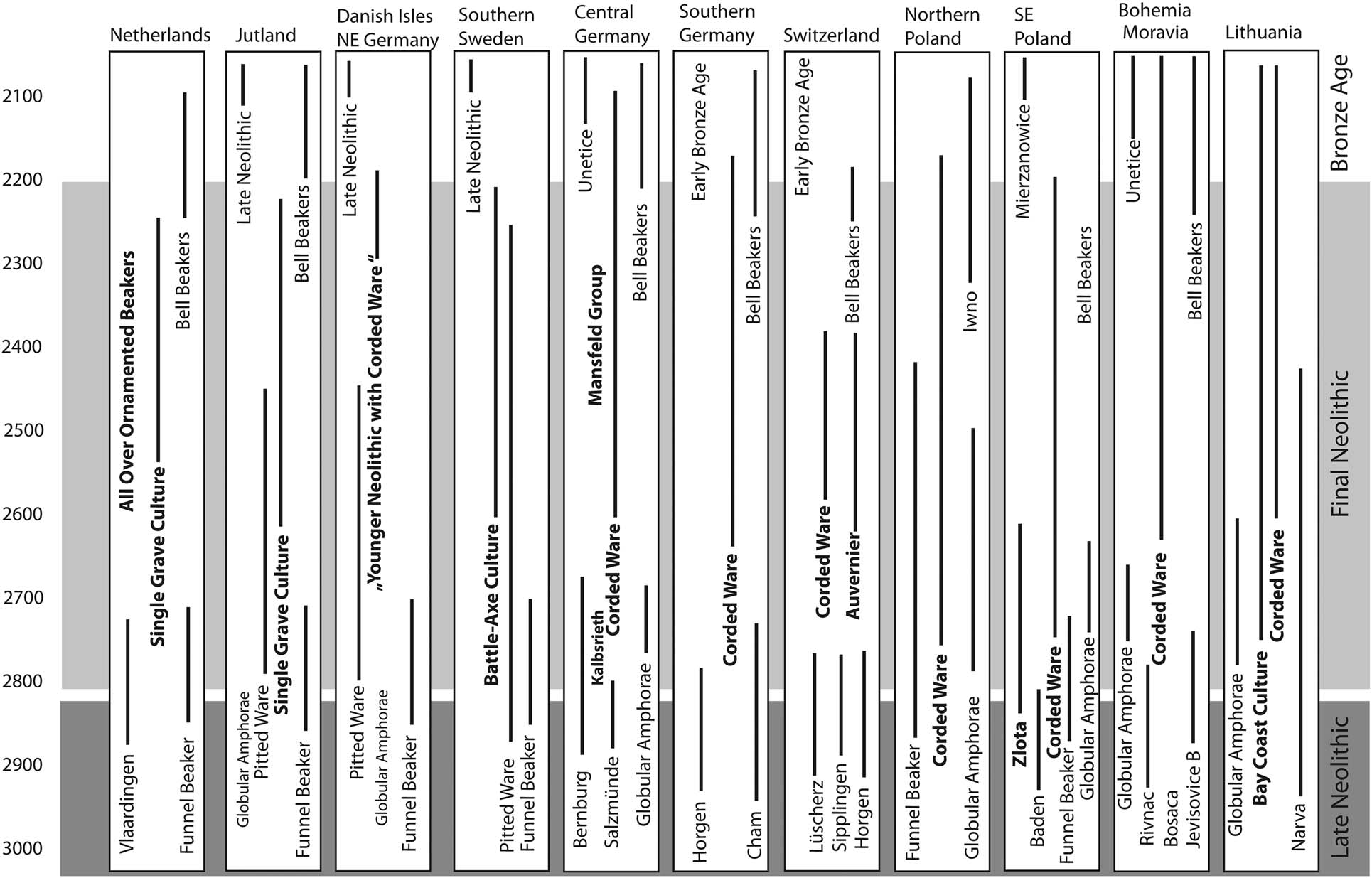
Conclusion
The evidence strongly points towards a long period of coalescence from 3000 to 2700 BC, when several innovations in burial customs, pottery, and tool types sprung forth from different places and subsequently spread via different networks of exchange and interaction. These surely showed a significant rise in scale, reach, and impact on local practices, but the same is true for the contemporary Globular Amphora and Yamnaya ‘Cultures’. This exchange resulted, roughly spoken, in a phenomenon like the A-Horizon.
(…)
Thus, it seems reasonable to explain the wide regional reach of those Corded Ware elements as the result of a general increase in mobility and thus an increase in the spatial extension of regional networks, triggered by the long-term effects of technological innovations and connected economic and social transformations in Europe since 3400 BC. It is the increase in mobility and regional networks that is new to the European Neolithic Societies after this time, and it is not only the Corded Ware elements, that are spread through these channels but also Yamnaya, Globular Amphorae, Bell Beaker ‘Cultures’, and copper and bronze artefacts in later periods. Those are archaeological classification units, heuristic tools for the ordering of finds, while brushing over variability and overlapping traits, and so they should not be confused with real social groups.
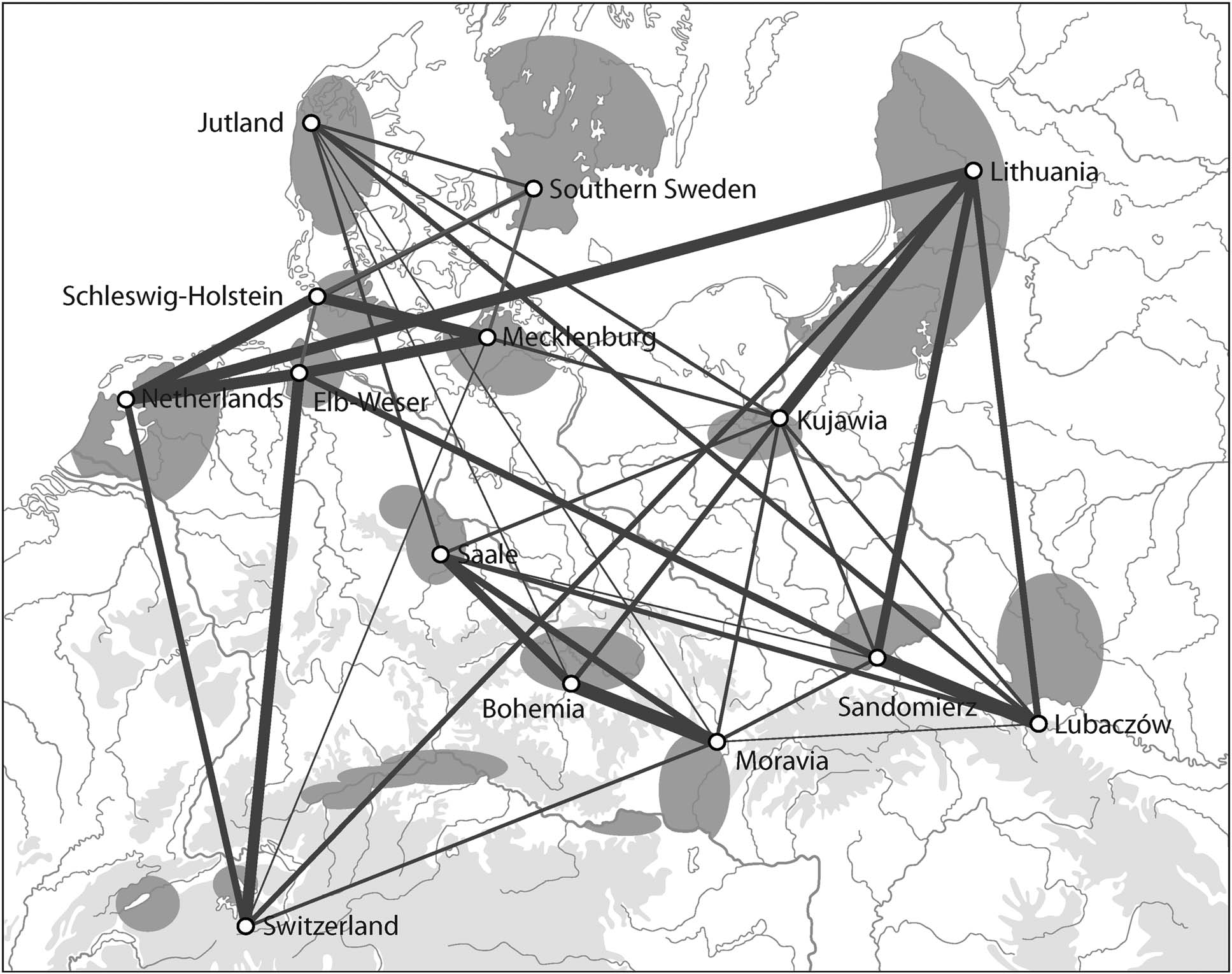
As a summary, we can say that there is still much work to be done on the origins and expansion of the Corded Ware culture, and that speculative interpretations of recent genetic papers (especially since 2015), based solely on scarce genetic finds, are not doing much in favour of sound anthropological models by connecting directly Yamna to Corded Ware (and the latter to Bell Beaker), as the multiple new anthropological ‘steppe’ models (and their unending revisions due to the gradual corrections from ‘Yamnaya’ to ‘steppe’ admixture in genetic papers) are showing.
Featured image, from Furholt’s article: Map of the Corded Ware regions discussed for central Europe. The dark shading indicates those regions where Corded Ware burial rituals are present regularly.
Related:
- Genetic prehistory of the Baltic Sea region and Y-DNA: Corded Ware and R1a-Z645, Bronze Age and N1c
- Science and Archaeology (Humanities): collaboration or confrontation?
- Massive Migrations? The Impact of Recent aDNA Studies on our View of Third Millennium Europe
- More evidence on the recent arrival of haplogroup N and gradual replacement of R1a lineages in North-Eastern Europe
- Stone Age plague accompanying migrants from the steppe, probably Yamna, Balkan EBA, and Bell Beaker, not Corded Ware
- Recent archaeological finds near Indo-European and Uralic homelands
- The new “Indo-European Corded Ware Theory” of David Anthony
- Bell Beaker/early Late Neolithic (NOT Corded Ware/Battle Axe) identified as forming the Pre-Germanic community in Scandinavia
- The concept of “Outlier” in Human Ancestry (II): Early Khvalynsk, Sredni Stog, West Yamna, Iron Age Bulgaria, Potapovka, Andronovo…
- The concept of “outlier” in studies of Human Ancestry, and the Corded Ware outlier from Esperstedt
- New Ukraine Eneolithic sample from late Sredni Stog, near homeland of the Corded Ware culture
- The renewed ‘Kurgan model’ of Kristian Kristiansen and the Danish school: “The Indo-European Corded Ware Theory”